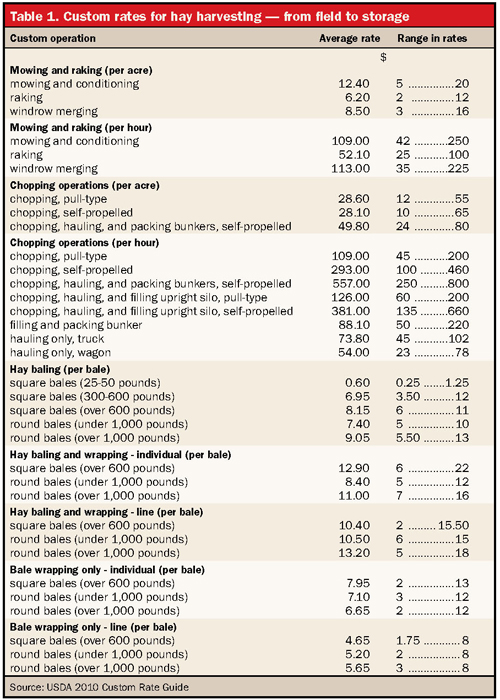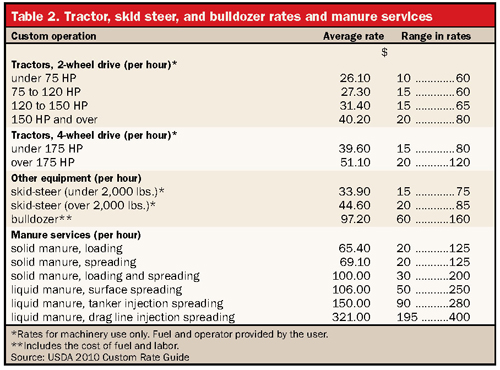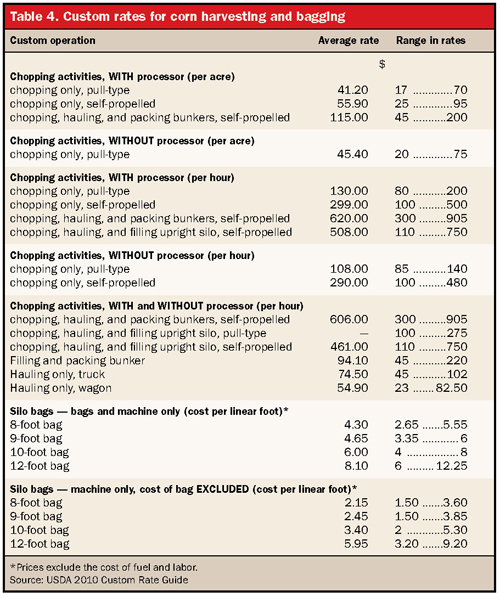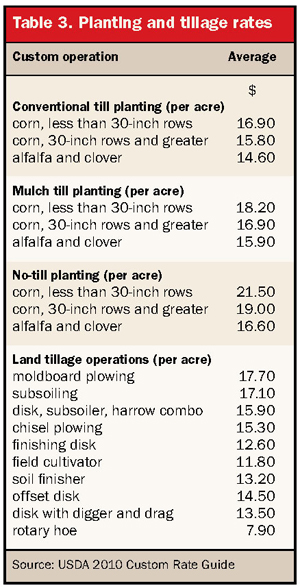As producers continue to specialize, the interest in custom work grows, as well. In order to get a better feel for what is being charged for these services, Wisconsin's National Agricultural Statistics Service field office conducted a statewide survey. Approximately 750 surveys were compiled from farmers who hire custom operators, custom operators and farmers who performed custom work, and machinery dealers who rent out equipment.
The rates in this article are ranges and averages of actual reported data for 2010. In these tables, most of the rates include the cost of hiring the machine with fuel and operator but exclude the cost of any materials. Tractor data found in Table 2 is based on only rental rates and excludes fuel and operator. The same situation applies for rental of silage bagging equipment shown at the bottom of Table 4. Meanwhile, the costs for bulldozing in Table 2 do include the cost of fuel and labor.

When looking at Tables 1, 2, and 4, you will note some wide ranges in the answers given. No attempt was made to distinguish between rates charged by custom operators who perform these operations as their main source of income and those who occasionally do custom work as a sideline.

Reports were edited to remove replies for which the respondent's figures were widely outside the range of other answers. The ranges provided for each category encompass at least 90 percent of the reported values.
Rates are typically influenced by fuel costs, soil conditions, topography, field size and shape, and type, age, and availability of equipment. When looking at these numbers, please keep in mind that machinery, fuel, and labor prices continue to go up. In the case of fuel, enough time has lapsed since the survey was initiated that fuel prices, when included in many categories, could cause rental rates to go up this year.
Table 1 includes field and storage practices performed on hay, while Table 4 involves corn silage. The bagging information in Table 4 applies to both hay and corn silage.


When looking at the tables, be sure to look at the bold heading found above each item. In parenthesis, you will find how each item is priced: by the acre, by the hour, by the bale, or per linear foot (silo bags). We only included rates more specific to the dairy industry.
A complete report can be found by going to www.nass.usda.gov/wi and clicking on "Wisconsin Custom Rate Guide 2010."
Click here to return to the Crops & Forages E-Sources
110525_366
The rates in this article are ranges and averages of actual reported data for 2010. In these tables, most of the rates include the cost of hiring the machine with fuel and operator but exclude the cost of any materials. Tractor data found in Table 2 is based on only rental rates and excludes fuel and operator. The same situation applies for rental of silage bagging equipment shown at the bottom of Table 4. Meanwhile, the costs for bulldozing in Table 2 do include the cost of fuel and labor.

When looking at Tables 1, 2, and 4, you will note some wide ranges in the answers given. No attempt was made to distinguish between rates charged by custom operators who perform these operations as their main source of income and those who occasionally do custom work as a sideline.

Reports were edited to remove replies for which the respondent's figures were widely outside the range of other answers. The ranges provided for each category encompass at least 90 percent of the reported values.
Rates are typically influenced by fuel costs, soil conditions, topography, field size and shape, and type, age, and availability of equipment. When looking at these numbers, please keep in mind that machinery, fuel, and labor prices continue to go up. In the case of fuel, enough time has lapsed since the survey was initiated that fuel prices, when included in many categories, could cause rental rates to go up this year.
Table 1 includes field and storage practices performed on hay, while Table 4 involves corn silage. The bagging information in Table 4 applies to both hay and corn silage.


When looking at the tables, be sure to look at the bold heading found above each item. In parenthesis, you will find how each item is priced: by the acre, by the hour, by the bale, or per linear foot (silo bags). We only included rates more specific to the dairy industry.
A complete report can be found by going to www.nass.usda.gov/wi and clicking on "Wisconsin Custom Rate Guide 2010."
110525_366








